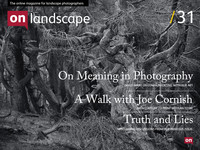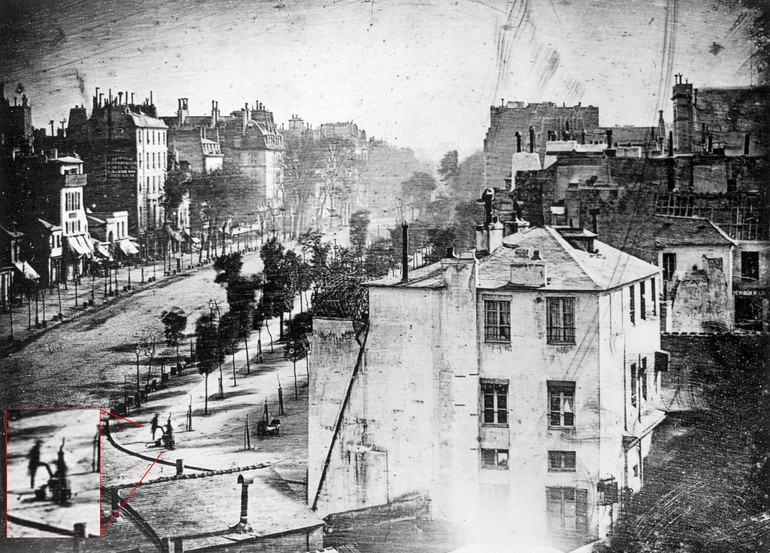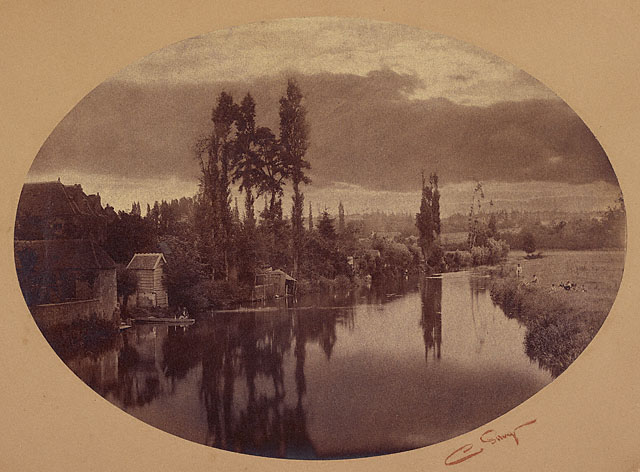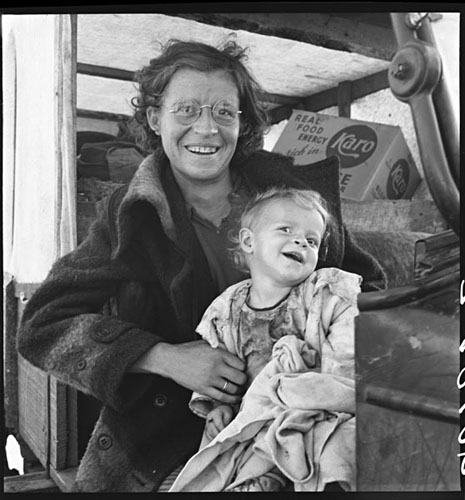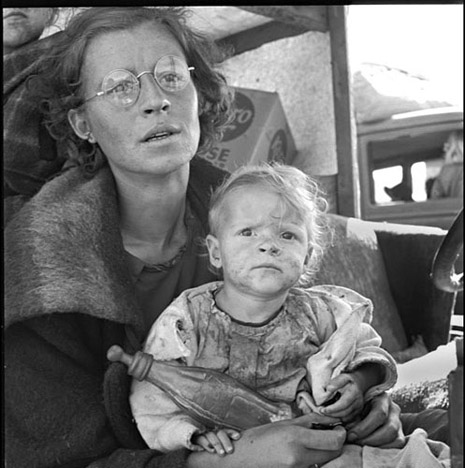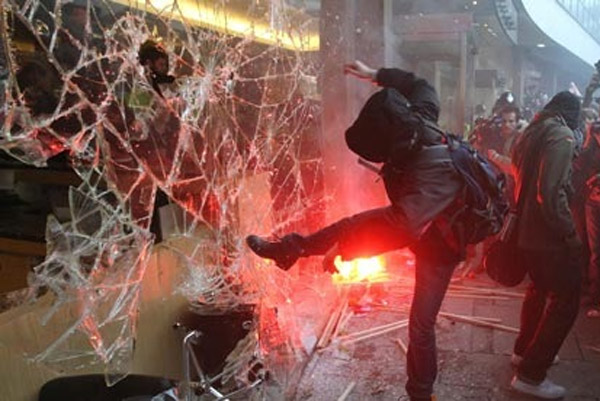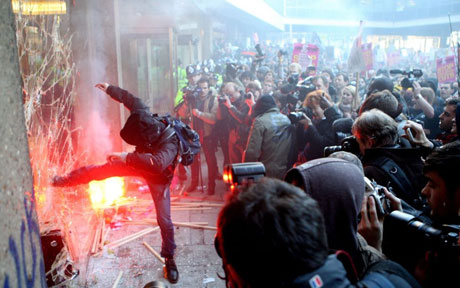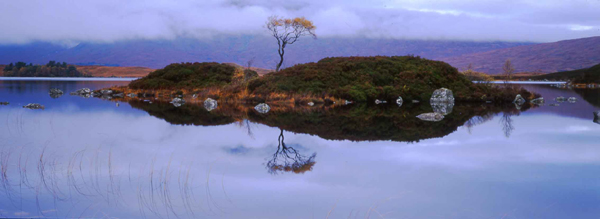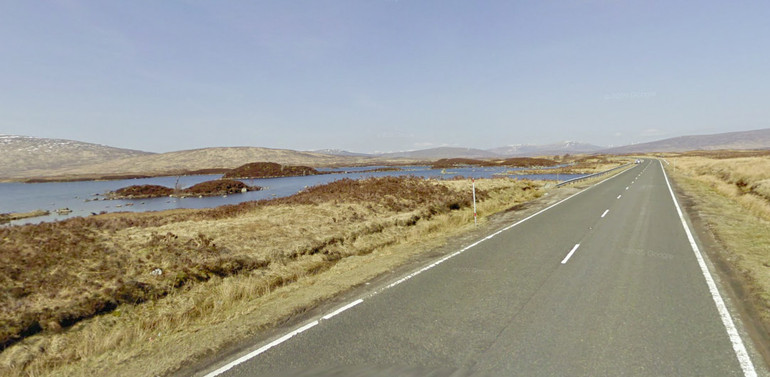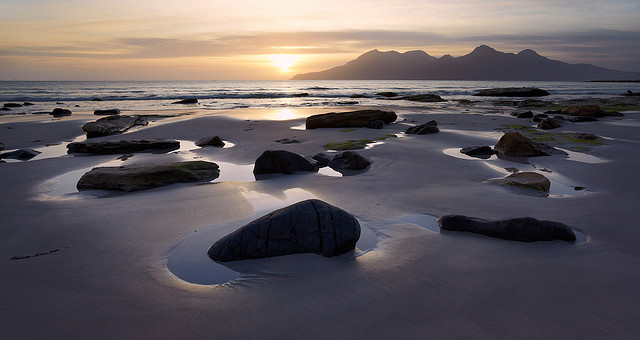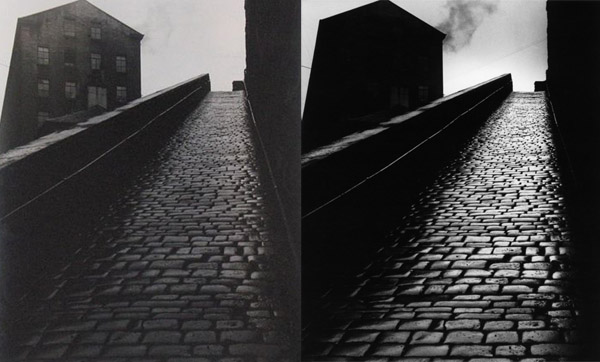Tim Parkin follows up on Ian Thompson's earlier article

Tim Parkin
Tim Parkin is a British landscape photographer, writer, and editor best known as the co-founder of On Landscape magazine, where he explores the art and practice of photographing the natural world. His work is thoughtful and carefully crafted, often focusing on subtle details and quiet moments in the landscape rather than dramatic vistas. Alongside his photography and writing, he co-founded the Natural Landscape Photography Awards, serves as a judge for other international competitions. Through all these projects, Parkin has become a respected and influential voice in contemporary landscape photography.
A recent article written by Ian Thompson on his wave photograph at Porth Cawl generated just a little bit more feedback than I or Ian expected. The main gist of the comments were along the lines of ‘this has gone too far’ or ‘this isn’t photography’. I thought it would be a good idea to take a look at the idea of truth and photography in a little more detail.
The Camera Doesn’t Lie
A very famous phrase suggests that what appears in a photograph is a direct reflection of reailty. However, even from the very first photographs we have had varying amounts of metaphorical or literal distortion. For instance, Louis Daguerre’s photograph taken in 1838, supposedly the first photograph of a human being, shows a street scene where a single figure stands on a corner having his shoes shined. Anyone who saw this picture at the time would think that the street was empty, early morning possibly. However it was the extremely long exposure needed that made all the people dissapear (a technique used by many architectural photographers).
And if we are talking about landscape photography, many of the early landscape photographers (Gustav le Gray for instance) used to have a library of sky photographs that they could combine with their landscape images in order to create a convincing whole or would have to take multiple shots with filters to capture the sky and foreground (Frank Meadow Sutcliffe). This could be taken as a necessity to capture skies because of the film used but they regularly picked skies from different locations for instance (skies that probably couldn’t exist in these locations because of atmospheric/geographic conditions). The following image by Camille Silvy is very well blended but for all we know those clouds would never form like that in that location. Although it is thought that they may be taken in the same location, there is no guarantee of this - hence the beginnings of doubt in landscape photography.
Or quite common in the mid 19th century are photo montages, combinations of multiple images into a single scene such as Henry Peach Robinson's "When the day's work is done". A scene as fictitious as the sentiment recorded and the following "Two Ways of Life" by Oscar Rejlander - a blend of many, many pictures.
Most of us probably know about the intentional photographic lies where individuals have been ‘darkroom’d out of photographs such as Trotsky from images where he stood close to Lenin or the Reichstag Flag raising. More recent changes such as OJ Simpson’s ‘darkening’ in Time magazine show a different distortion that is insidious in its subtlety.
However, let us take a look at a photograph taken in 1939.
What we have here is a mother and baby looking like they are enjoying themselves having just gone to pick up the shopping. The more famous version of this picture, taken a few moments earlier is this..
So here we have the image chosen by Dorothea Lange for the Farm Security Administration’s representation of the Great Depression. Which one of these photographs is the truth? Obviously the choice of photograph was made influenced by the message the FSA wanted to put forward. (more info here)
Both of these are a lies to some extent - the first is a lie where the subject has decided to show the photographer that they are happy and have a happy, clean baby (the father cleaned the babies face). The second photograph, the one that was taken first, lies in that it only shows a single aspect of the subjects life having just arrived at a food shelter after a long car journey (I look pretty bad after eight hours in the car too).
A more subtle lie that photographers make is through elimination and choice. For instance, a documentary photographer, Supanit Riansrivilai, was criticised recently when they produced a series of photographs depicting the Polish city of Krakow. The criticism was based on the fact that through choosing only to take photographs that depicted her own vision of what communist depression was about. This scenario mirrors the photographs taken by Russian spies of the US where they wanted to depict the human fallout of a capitalist state. By only showing one part of reality they created a new version of it that didn't exist.
Given these particular ‘lies’, lets try to construct a list of ways in which photography can lie without ‘manipulating’ images.
1) Through conscious choice and elimination of parts of a ‘reality’ in a series of images, thereby creating a distorition of the truth. This is particularly true in landscape photography where many people want to create ‘beautiful’ photography in crepuscular light, showing bucolic pastoral scenes. However, the countryside isn’t like this - much of it is agricultural, it spends most of it’s time under high sun with contrasty shadows etc and in many cases it can be quite dull or barren.
2) Through choice of subject or by cropping of the subject to represent a different truth. For example this image from the front pages of most newspapers at the time ...
.. looks very different when you see the whole picture?
. Does this photograph mean the same thing? I would say the story has changed substantually. We do the same when we photograph many of our favourite icons - eliminating the fact that they are next to main roads or popular paths and doing our damndest to make people think we are in the deep wildernerss. Take the tree at Lochan Na h’Achlaise (since blown down)
this is literally a few dozen feet from the biggest road on the west coast of Scotland and yet a viewer would think it was in the middle of the wilderness and that the photographer was an intrepid explorer.
3) Through the use of non standard focal length lenses, particularly wide angle lenses. The most recent example of this in my experience was that when I visited the Isle of Eigg, I expected to see Rhum quite small on the distant horizon.
In actual fact Rhum sits quite close to Eigg and encompasses so much of the horizon that it is difficult to take photographs from the north side of the island without including it. Here is a shot showing how close Eigg and Rhum actually are..
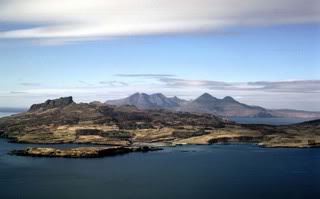 In fact when the first very wide angle lenses were used, people struggled to understand what they were seeing in pictures because the distortion of perspective did not make sense - they didn’t recognise the locations in photographs for instance.
In fact when the first very wide angle lenses were used, people struggled to understand what they were seeing in pictures because the distortion of perspective did not make sense - they didn’t recognise the locations in photographs for instance.
4) Through colour balance. Our eyes do a fantastic job of correcting colour casts in the real world, we are so good at doing this that we don’t notice that at midday in blue sky weather, the landscape is quite cold looking. Our eyes adjust for this and keep on adjusting until the sun gets very low in the sky and has become very warm. It is only when the sun gets very low that are eyes cannot compensate for the colour cast any more and everything takes on the hues of the ‘golden hour’ (which is why you can still get great light well before you can see it with your eyes).
With the camera though, we can adjust or fix the colour balance and show images with intense tones that are dramatically different than that which we would have experienced had we been there ourselves.
One of the intriguing things about colour balance is that we can override our subconscious and learn to see it. For instance, most people who have not looked hard at the world will not say that shadows are blue. However, if you get used to this fact, you start to see the blue shadows on clear sky days - so when one person says the shadow is blue and the other one says it isn't, who is correct and who lies?
5) Through saturation. Don’t we all know this one - I think everyone has seen a picture or two that has had their eyes itching and even the subtler levels of saturation boosting depict a strange form of reality. Although this is not necessarily lying, it is certainly deceiving to some extent.
A second aspect of saturation that lies is the total elimination of colour - black and white photography is the original distortion. By removing one of the important cues we have about reality, we are creating a fiction, however aesthetically pleasing that fiction is. Black and white also allows us to us colour filters to change a blue sky to a black one using a red filter or to make foliage 'glow' using a green filter.
6) Through the actions of the photographer whilst taking the photograph. I'll stick to landscape photography here to keep things on topic but there are many examples outside (include Capa's Spanish civil war 're-enactment' and various other staged ware photographs). I suppose the most extreme example of this is Edouard Muybridge's admission of clearing "trees by the score that interfered with the cameras / best point of sight". I suppose you could say he wasn't lying because that is what the landscape looked like, after he had finished with it at least.
Less invasive perhaps, but bringing up the same questions is our fond habit of 'gardening' the scene. Removing or arranging parts of the foreground to better suit our composition. Many photographers talk about this as being more morally correct that using photoshop to remove these items in post processing but I do wonder what the difference is in terms of 'honesty'.
Manipulation
So straight photography isn't purely truthful in the first place, even before you consider manipulation. But once we start to look at manipulation, a whole new set of issues appear. How far can we take digital (or analog) manipulation before we start to lie.
Reading through the hundreds of comments on Ian Thompson's article about the 'wave' picture that was composited from multiple photographs, it really makes it clear that this is an issue that photographers feel very strongly about (whatever their opinion). The points of view range from "the capture is sacrosanct" to "everthing goes" but at first glance there seems to be a few milestones along that path. I'll list a couple here..
1) The first milestone can probably be described thus "Items can be removed but not added and those items removed should be transient with respect to the landscape". So this means that it's OK to remove cars and rubbish but it's not OK to remove stone walls and trees. However, when you look closely at this, things get a little messy. For instance, some rubbish does not degrade at all - many plastics will be around long after we've died. And some things we think of as permanent could be gone, for instance the trees on Rannoch moor that have recently been blown over. Does that means we have to set a time limit on how long things last or do we class 'rubbish' as something that is OK to delete regardless of the amount of time it will be there for (and can we class pylons as rubbish in that case?). And as for transient, clouds are probably the most transient thing in most peoples pictures, is it OK to remove a few of them if they aren't adding to the picture?
2) "It's OK to add and remove things as long as the intrinsic documentary nature of the subject is preserved". This sounds easy to understand, the landscape is the truth and as long as we represent it as truth then we're OK. But what truth? It's probably a little fascetious but if a Llama wandered into your photo of Loch Sunart in Ardnamurchan would you keep it in because there are Llama wandering around the shoreline or remove it because Llama aren't a native species? The problem with a definition like this is that it's subjective - we all have our own interpretation of what the landscape is and this interpretation will dictate what we can or can't do - meaning what is OK for one person won't be for another.
So it seems that even when we have some form of shared vocabulary about our level of tolerance of 'distortion', the finer points mean that we might not be in agreement as much as we think we are. So let's take a look at where this idea of 'pure' photography comes from by looking at some of the 'masters' of photography (hopefully biased towards landscape).
Ansel Adams - One of the supposed bastions of truth in photography but the use of black and white images, strong colour filters and quite extreme darkroom manipulations - for instance in Moonlight over Hernandez was manipulated to remove many of the clouds from the top of the picture (particularly the clouds to the right hand side of the moon)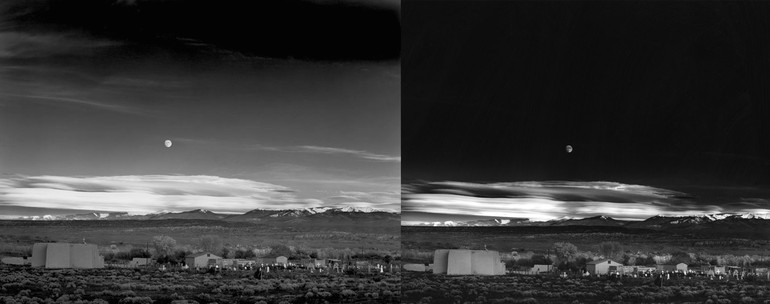
Bill Brandt - A British master of photography and one know to use the darkroom to quite dramatically change the tonality of his pictures. A good example of which is "The Snicket" which when printed straight shows a lot of detail in the building at the top of the cobbled street. Brandt's darkroom work creates a starker picture where any detail in the building has been completely burned in (darkened to black).
When colour arrived in full swing in the 1950's/1960's, photographers did not manipulate quite as much, mostly because it was too difficult to do so. There were a few colour photographers who did have the skills to manipulate and some of them chose to occasionally 'tweak the truths nose' a little. For example, it seems to me quite obvious that some of Michael Fatali's shots have been manipulated in terms of colour and tone but more importantly for our discussion, he also introduced (or enlarged) celestial and atmospheric conditions. Take the moon in this shot - according to some quick calculations, he would have needed a 1000mm lens to capture the moon at this size in the frame. Even on 8x10 this 1000mm lens is equivalent to a 180mm lens, hardly the wide angle suggested by the perspective of the composition.
Now that we live in a world of digital photography where even film captured images can be piped through the magic of photoshop before creating a final 'darkroom' print, the ability to edit images has been democratised. There is a huge range of free and cheap software out there that you can use to 'photoshop' your images, it should be no surprise that some people do so.
One of the questions that was raised during the discussion in Ian's article was 'Has the bond between photography and the truth been broken'. Having looked at some of the examples above, I would have to say that this bond was fragile to begin with. It may be that in the current era the expectation of truth in photography is weaker than it once was but I would say that it is up to the artist to decide how to answer the question "Did you do anything to that?".
This hasn't stopped people trying to regulate landscape and wildlife photography in some way, even going so far as to propose some form of kite mark to record what level of truth the image includes. Perhaps Ansel Adams' recent exhibition should have contained warnings about 'Moonrise' saying "significant darkroom work applied and elements removed" - would this have helped the viewer enjoy the image? Attempts such as this are always going to be difficult and self regulation seems the only real way to go - especially when the people who are the real villains are those who actively deceive people, suggesting that there pictures are straight out of camera (SOOC) when in fact they have applied all sorts of trickery. Michael Fatali famously set fire to some fire bricks to create some nice smoggy effects whilst leading a course and allegedly added or enlarged moons in many of his desert temple such as Back of Beyond and possibly pasting in mammatus clouds in The Crossing (a meteorologist friends assured me that mammatus such as that don't stretch to the horizon and would be quite small with a wide angle lens). Another photographer alleged to have manipulated his images that insists not is Peter Lik - his latest piece, Bella Luna, is almost certainly a combination of two or more images. The narrative associated with the image "I pressed the shutter, a feeling I'll never forget. The moon, tree, and earth." certainly implied a single moment of capture.
And that is possibly what people want to preserve when they talk about truth in photography - that a single moment of capture created the final image; not multiple captures that have been blended together to create a composite. However, this 'category' of straight photography, however blurred by gardening, subtle cloning etc. is only one aspect. Many photographers wish to evoke the memory or emotion of a place or moment in time and use whatever is in their creative arsenal to achieve this. Ian Thompson's image is perhaps a visualised moment that Ian was unable to capture in a single exposure but he still wants to share what he felt at the time and who is to say that what he did to achieve this is wrong?
Ultimately, photography has been used throughout it's relatively short history as a way of both representing reality and fiction - the viewer is not tied to a single way of understanding the image and it is up to the photographer to suggest ways of viewing just as the cinematographer adds 'based on a true story' to their works of art. No one expects 127 hours to all be the actual recordings of events that happened but they still connect it with reality. Likewise I don't think many people expect fine art to be a pure recording of the truth unless they are specifically told that it is.
As for the limits of what is and isn't photography, like many things in the english language, it is defined by usage and people call images that were primarily recorded by light onto a sensor a photograph. The problem we face if we try to provide definitions is how to cope with edge cases - a colleague runs a roll of 120 through his camera and then sends it to America to get another photographer to expose it again. The constructions don't record the same instant or even the same continent - are they still photographs?
The most sensible course of action is to let each person define their own moral/ethical boundaries and, where possible, help the viewer to understand what they are.

